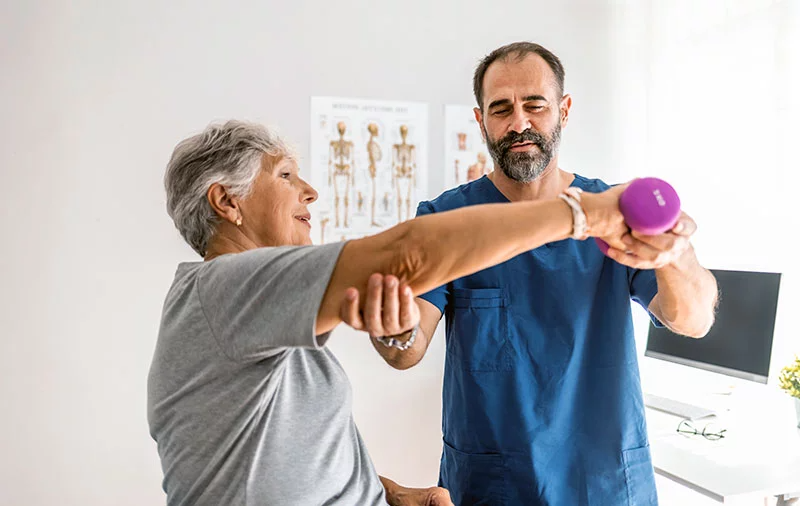HEALTH
What Are Some Of The Long-Term Effects of Untreated Spasticity?

Spasticity is a neurological condition characterized by involuntary muscle stiffness, spasms, and exaggerated reflexes. It commonly occurs in individuals with conditions such as cerebral palsy, multiple sclerosis, stroke, traumatic brain injuries, and spinal cord injuries. When left untreated, spasticity can lead to severe complications that significantly impact mobility, daily functioning, and overall quality of life. This article explores the long-term effects of untreated spasticity and emphasizes the importance of timely intervention.
Progressive Muscle Contractures and Joint Deformities
One of the most serious consequences of untreated spasticity is the development of muscle contractures and joint deformities. Due to continuous muscle contractions, the affected muscles become stiff and shorten over time, restricting joint movement. This can lead to:
- Joint stiffness and immobility – The inability to fully extend or flex joints, causing pain and difficulty with movement.
- Fixed contractures – Permanent muscle shortening that may require surgical intervention.
- Skeletal deformities – Abnormal postures and misalignments, such as scoliosis, hip dislocation, or foot drop, which can impair mobility and independence.
Chronic Pain and Discomfort
Spasticity can cause persistent muscle tension, leading to chronic pain and discomfort. Individuals may experience:
- Muscle fatigue and soreness due to constant contractions.
- Joint pain from excessive stress on bones and cartilage.
- Nerve compression resulting from abnormal positioning of muscles and joints, leading to neuropathic pain. Over time, untreated pain can reduce a person’s tolerance for movement and physical activity, exacerbating muscle weakness and further restricting mobility.
Reduced Mobility and Loss of Independence
As spasticity worsens, individuals may struggle with walking, standing, or using their limbs effectively. This leads to:
- Increased reliance on assistive devices such as wheelchairs, braces, or walkers.
- Reduced ability to perform daily tasks like dressing, eating, and personal hygiene, decreasing overall independence.
- Higher risk of falls and injuries due to poor balance and uncontrolled muscle spasms. Untreated spasticity can significantly limit a person’s ability to engage in social, occupational, and recreational activities, affecting their overall well-being.
Skin Breakdown and Pressure Sores
People with severe, untreated spasticity often have difficulty shifting positions, leading to prolonged pressure on certain areas of the body. This increases the risk of:
- Pressure ulcers – Also known as bedsores, these occur when blood flow to the skin is restricted due to prolonged immobility.
- Skin infections – Open wounds from pressure sores can become infected, leading to serious health complications.
- Poor circulation – Restricted blood flow due to muscle stiffness can slow the healing process and increase susceptibility to skin damage. Preventing pressure sores requires frequent repositioning, proper support surfaces, and regular skin checks, but untreated spasticity makes these measures difficult to implement effectively.
Also Read: How SEO Agencies Help Businesses Propel Visibility
HEALTH
How Family Health Insurance Agents Help Secure Your Loved Ones’ Health

Finding the right health insurance is a crucial step in ensuring the well-being of a family. With so many plans and providers available, navigating the options can be overwhelming. Insurance agents play a vital role in simplifying the process and guiding families toward the best coverage. These professionals ensure families receive the protection they need within their budget. Understanding how these agents help secure a family’s health can provide clarity for those seeking coverage.
Personalized Guidance Through Health Insurance Choices
Health insurance agents focus on understanding each family’s unique needs. Family health insurance agents take time to assess factors like medical histories, preferred doctors, and future health needs instead of offering a one-size-fits-all solution. This information allows the agent to recommend the best policy, whether it’s a comprehensive plan or one tailored to specific needs.
Agents also help families compare the benefits and drawbacks of different plans. Whether it’s a PPO or an HMO, a family health insurance agent explains how these plans work in terms of coverage, cost, and flexibility. This ensures families don’t pay for unnecessary services or face unexpected out-of-pocket expenses.
Offering Expert Knowledge on Coverage Options
Health insurance policies can be complex, with various coverage options and exclusions. Insurance agents help families choose the right coverage based on their needs, staying up-to-date with the latest policy changes and regulations. Agents understand the details of different plans and what each provider offers. Whether families need dental, vision, or prescription coverage, they can identify which plans include these services, ensuring families get the best coverage without overpaying.
Assistance With Claims and Paperwork
One of the most helpful roles that health insurance agents provide is in navigating the often overwhelming paperwork and claims process. Health insurance policies come with a significant amount of documentation, and keeping track of it all can be a daunting task. An agent can help interpret this information, explaining policy details in easy-to-understand terms. In the event of a medical claim, agents ensure that all necessary paperwork is filed correctly and promptly. They assist in making sure claims are processed smoothly, reducing the chances of a delay or rejection.
Advocating for Families in Times of Need
Health emergencies are stressful enough without insurance issues. Insurance agents act as advocates, negotiating on behalf of clients when claims are denied or coverage is refused. They provide peace of mind by assisting families in securing additional coverage or adjusting plans to meet changing needs, such as adding coverage for a new child or medical needs. This support helps families navigate critical moments with minimal stress. Agents also ensure families understand their policies, making the process smoother and more manageable.
The Value of Expert Support in Insurance Decisions
When considering health insurance options, having an expert on hand can make a significant difference. Insurance agents offer valuable insights during the decision-making process. They not only help families find the right coverage but also ensure that the plan is sustainable long-term. With their guidance, families can avoid costly mistakes and ensure their health needs are met in the most efficient way possible.
Family health insurance agents are indispensable resources for securing the health and financial well-being of a family. From offering expert knowledge of coverage options to assisting with paperwork and claims, these agents provide a comprehensive service that simplifies the often complicated world of health insurance. Families can rest easy knowing that they have a trusted advisor who is working in their best interest, making health insurance a little less intimidating and a lot more accessible. With their guidance, families can make informed decisions and find the best plans for their specific needs.
HEALTH
What to Expect from a Lip Filler Treatment in Scottsdale

Lip filler treatments have grown in popularity, allowing individuals to enhance their lips’ natural shape and volume. Scottsdale offers a variety of options for those looking to achieve a more youthful, plump look. These treatments are designed to improve the appearance of the lips without the need for invasive surgery. But what exactly can someone expect when considering lip fillers in Scottsdale?
The Consultation Process
The consultation is a critical step before undergoing any lip filler treatment. For example, during a Scottsdale lip filler at Adam & Eve Medical Aesthetics, the professional will assess the individual’s facial structure and desired outcomes. This helps ensure the treatment is tailored to meet specific aesthetic goals. It is also important for the practitioner to understand any medical history that could affect the procedure.
A discussion about the various types of fillers available, as well as the potential risks and benefits, will also take place. It is important to understand the procedure clearly, and a reputable provider will take the time to answer any questions. Whether looking to add fullness to the lips or define their shape, a personalized treatment plan is key.
What Happens During the Treatment?
Once the consultation is complete, the lip filler procedure can begin. The process usually starts with the application of a topical numbing cream to the lips, which minimizes any discomfort during the injection. After the area is numbed, a fine needle injects the selected dermal filler into the lips. The practitioner will inject small filler at strategic points to ensure the lips have a balanced, natural look.
The procedure typically takes about 30 minutes to an hour, depending on the complexity of the treatment. There is usually minimal downtime, and many individuals can return to normal activities immediately after the procedure. Some swelling or bruising may occur, but this tends to subside within a few days.
The Types of Lip Fillers
There are several types of lip fillers available in Scottsdale. The most commonly used are hyaluronic acid-based fillers. These fillers naturally occur in the body, which makes them a safe and effective choice for many individuals. Hyaluronic acid attracts and retains moisture, helping add volume to the lips.
Other options include collagen-based fillers and fat injections, though these are less common. Collagen-based fillers were popular in the past, but hyaluronic acid fillers have largely replaced them due to their more predictable and longer-lasting results. Fat injections, while offering permanent results, require liposuction from another part of the body, making them a more involved procedure.
Enhancing Natural Beauty with Scottsdale Lip Filler Treatments
Scottsdale lip filler treatments allow individuals to enhance their natural beauty with subtle yet effective results. These treatments are designed to offer customized solutions that meet each person’s unique needs, utilizing advanced techniques to achieve the desired look.
Lip filler treatments in Scottsdale offer a non-invasive solution for individuals seeking to enhance their lips’ appearance with natural-looking results. Whether aiming for subtle volume, definition, or fullness, these treatments provide a personalized approach to achieving the desired aesthetic goals. For example, Scottsdale lip filler at Adam & Eve Medical Aesthetics offers a range of filler options to suit different needs and preferences. With a straightforward procedure, lip fillers have become an accessible choice for those looking to boost their confidence and enjoy lasting results with minimal downtime.
HEALTH
What Are the Hidden Risks of Ignoring Minor Heart Palpitations?

Heart palpitations—those sudden flutters, skipped beats, or rapid thumps in your chest—can be alarming, even when they last only a few seconds. For many people, they are dismissed as minor, especially when they come and go without pain or major discomfort. However, what seems minor today could be a warning sign of deeper, hidden cardiovascular issues tomorrow. Among the potential consequences of ignoring these symptoms is the development of serious conditions such as Atrial Fibrillation, a common and potentially dangerous heart rhythm disorder.
Why Minor Palpitations Deserve Attention
It’s easy to brush off occasional heart palpitations, especially if you’re under stress, consumed caffeine, or just finished exercising. In some cases, these are normal responses to temporary stimuli. But when palpitations happen more frequently, last longer, or appear without a clear cause, they may indicate an underlying problem with the heart’s electrical system.
The biggest concern isn’t necessarily the palpitations themselves, but what they may be signaling beneath the surface. Conditions like Atrial Fibrillation can start subtly, with occasional episodes that are easy to miss or ignore. Left undiagnosed and untreated, these conditions can escalate into more serious complications, including stroke, heart failure, or long-term damage to the heart muscle.
Understanding Atrial Fibrillation and Its Link to Palpitations
Atrial Fibrillation (AFib) is characterized by a rapid and irregular heartbeat originating from the upper chambers of the heart (the atria). It can cause the heart to beat as fast as 150–200 times per minute in some cases. Not all people with AFib experience dramatic symptoms right away. In fact, many first notice it as a series of minor palpitations or a vague sensation of their heart “skipping” or “fluttering.”
These subtle episodes can be intermittent and may resolve on their own, a condition known as paroxysmal AFib. Because the episodes may be brief and infrequent at first, people often delay seeing a doctor—sometimes for years—until the symptoms become more intense or dangerous. Unfortunately, during that time, the risk of stroke and other complications silently increases.
The Hidden Dangers of Ignoring Symptoms
Ignoring minor palpitations can allow Atrial Fibrillation to progress unchecked. Here are some hidden risks associated with this approach:
- Increased Stroke Risk: AFib causes blood to pool in the atria, increasing the risk of clot formation. These clots can travel to the brain, leading to a stroke. Individuals with untreated AFib are five times more likely to suffer a stroke than those without the condition.
- Heart Failure: The irregular rhythm associated with AFib can weaken the heart over time, especially when the lower chambers are forced to pump inefficiently. This can lead to chronic fatigue, shortness of breath, and eventually, heart failure.
- Structural Heart Damage: Persistent, untreated rhythm issues may stretch and scar the heart’s atrial tissue. As Atrial Fibrillation becomes more entrenched, it also becomes more difficult to treat effectively.
- Decreased Quality of Life: Even if palpitations don’t immediately threaten your life, they can reduce energy levels, disrupt sleep, and create constant anxiety about your heart’s health.
Risk Factors That Make Palpitations More Concerning
While not every palpitation signals trouble, certain risk factors increase the likelihood that minor symptoms are part of something more serious like Atrial Fibrillation. These include:
- High blood pressure
- Diabetes
- Obesity
- Sleep apnea
- Excessive alcohol or caffeine use
- Family history of heart disease
If you have one or more of these risk factors and are experiencing palpitations—even occasionally—it’s worth discussing them with a healthcare provider.
When to See a Doctor
If palpitations are accompanied by symptoms like chest pain, dizziness, fainting, or shortness of breath, seek medical attention immediately. These may indicate a serious heart issue in progress. But even if your symptoms are mild or fleeting, it’s wise not to ignore them—especially if they’re occurring regularly or for no obvious reason.
A doctor may recommend monitoring your heart rhythm through an ECG, Holter monitor, or wearable device. If Atrial Fibrillation is detected, treatment can begin early, often with better outcomes.
Proactive Steps for Peace of Mind
Being proactive about heart health means listening to your body and acting early. Regular check-ups, staying informed about conditions like Atrial Fibrillation, and tracking any unusual symptoms can help you avoid serious outcomes. You don’t need to panic over every flutter—but you shouldn’t ignore repeated or unexplained palpitations either.
Also Read: Dave Watkin Aggreg8: Transforming Data into Business
Conclusion
Minor heart palpitations might not seem like a big deal, but they can be the earliest sign of a larger, more dangerous issue—especially when related to Atrial Fibrillation. Ignoring them could mean missing the opportunity for early diagnosis and effective treatment. By paying attention, seeking medical advice when needed, and understanding your personal risk factors, you can protect your heart now and in the future. Your health is worth the attention—even when the symptoms seem small.
-

 GAMING6 months ago
GAMING6 months agoSFM Compile: How to Optimize Your Renders for the Best Results
-

 CRYPTO6 months ago
CRYPTO6 months agoCrypto30x.com Avalanche: Revolutionizing the Future of Crypto Trading
-

 CRYPTO6 months ago
CRYPTO6 months agoThe Truth About Crypto30x.com Catfish: Protect Your Investments
-

 FASHION5 months ago
FASHION5 months agoThe Ultimate Guide to Printable Party Invites
-

 BLOG6 months ago
BLOG6 months agoLogicalShout News: Stay Ahead with Reliable and Timely Information
-

 GAMING6 months ago
GAMING6 months agoDisney Card Game TechInsiderz.com: Everything You Need to Know
-

 BIOGRAPHY7 months ago
BIOGRAPHY7 months agoDrew Brees Makes His NBC Debut, Internet Amazed By His New Hair
-

 BLOG6 months ago
BLOG6 months agoDiscover Fauxmoi: The Platform Where Pop Culture Fans Thrive
